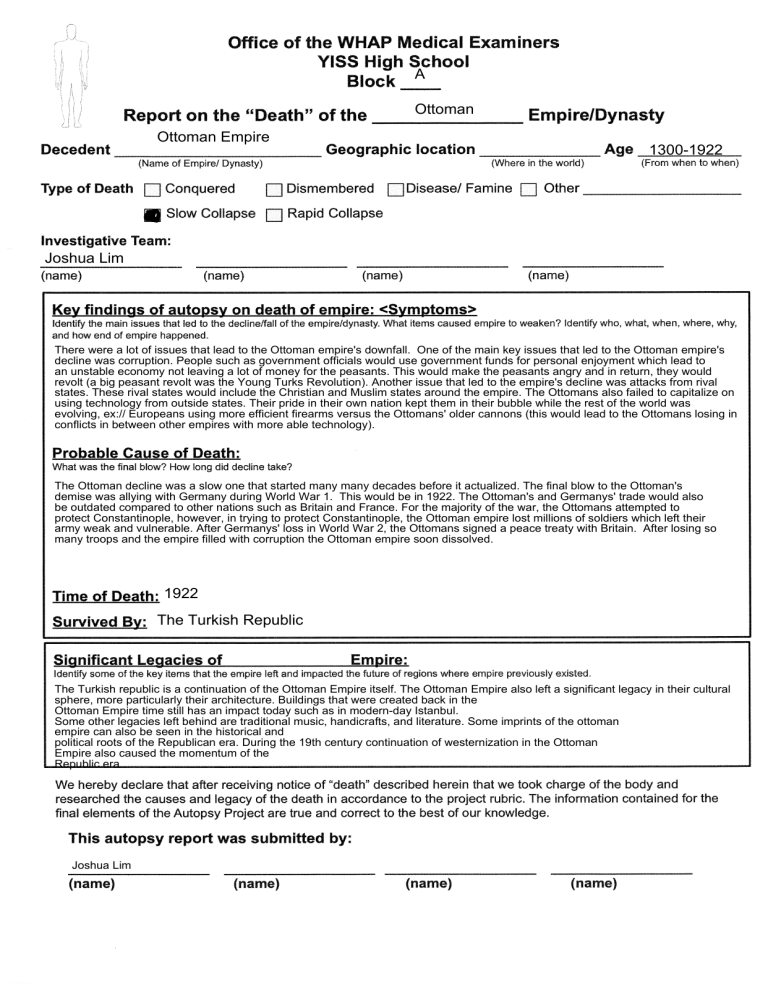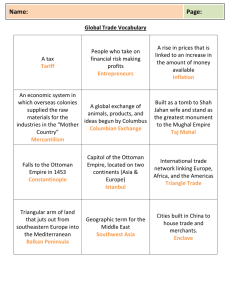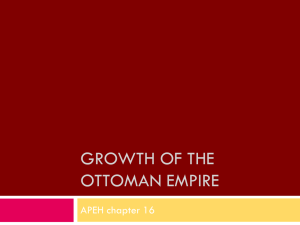
A Ottoman Ottoman Empire 1300-1922 Joshua Lim There were a lot of issues that lead to the Ottoman empire's downfall. One of the main key issues that led to the Ottoman empire's decline was corruption. People such as government officials would use government funds for personal enjoyment which lead to an unstable economy not leaving a lot of money for the peasants. This would make the peasants angry and in return, they would revolt (a big peasant revolt was the Young Turks Revolution). Another issue that led to the empire's decline was attacks from rival states. These rival states would include the Christian and Muslim states around the empire. The Ottomans also failed to capitalize on using technology from outside states. Their pride in their own nation kept them in their bubble while the rest of the world was evolving, ex:// Europeans using more efficient firearms versus the Ottomans' older cannons (this would lead to the Ottomans losing in conflicts in between other empires with more able technology). The Ottoman decline was a slow one that started many many decades before it actualized. The final blow to the Ottoman's demise was allying with Germany during World War 1. This would be in 1922. The Ottoman's and Germanys' trade would also be outdated compared to other nations such as Britain and France. For the majority of the war, the Ottomans attempted to protect Constantinople, however, in trying to protect Constantinople, the Ottoman empire lost millions of soldiers which left their army weak and vulnerable. After Germanys' loss in World War 2, the Ottomans signed a peace treaty with Britain. After losing so many troops and the empire filled with corruption the Ottoman empire soon dissolved. 1922 The Turkish Republic The Turkish republic is a continuation of the Ottoman Empire itself. The Ottoman Empire also left a significant legacy in their cultural sphere, more particularly their architecture. Buildings that were created back in the Ottoman Empire time still has an impact today such as in modern-day Istanbul. Some other legacies left behind are traditional music, handicrafts, and literature. Some imprints of the ottoman empire can also be seen in the historical and political roots of the Republican era. During the 19th century continuation of westernization in the Ottoman Empire also caused the momentum of the Republic era. Joshua Lim Joshua Lim The Slow Death of the Ottoman Empire There were a lot of issues that lead to the Ottoman empire's downfall. One of the main key issues that led to the Ottoman empire's decline was corruption. People such as government officials would use government funds for personal enjoyment which lead to an unstable economy not leaving a lot of money for the peasants. This would make the peasants angry and in return, they would revolt (a big peasant revolt was the Young Turks Revolution). Another issue that led to the empire's decline was attacked from rival states. These rival states would include the Christian and Muslim states around the empire. The Ottomans also failed to capitalize on using technology from outside states. Their pride in their own nation kept them in their bubble while the rest of the world was evolving, ex:// Europeans used more efficient firearms versus the Ottomans' older cannons (this would lead to the Ottomans losing in conflicts in between other empires with more able technology). There were various factors that weakened the Ottoman Empire. Most of it stemmed from stubbornness and bad judgment. Their stubbornness to use technology from other states made them behind and left them vulnerable to the power of newer technology. The Ottoman Empire also had corrupt and self-gratifying sultans who would spend heaps of money on themselves and their wives instead of using that money for the Empire. It could be argued that this is not the Sultan's fault but rather the fault of the political system, whenever there is a dictatorship the empire almost never stays afloat for a long time. Bad decisions from leaders also led to the weakening of the empire ex:// siding with Germany during WWI. The Ottoman decline was a slow one that started many many decades before it actualized. The final blow to the Ottoman's demise was allying with Germany during World War 1. This would be in 1922. The Ottoman's and Germanys' trade would also be outdated compared to other nations such as Britain and France. For the majority of the war, the Ottomans attempted to protect Constantinople, however, in trying to protect Constantinople, the Ottoman empire lost millions of soldiers which left their army weak and vulnerable. After Germanys' loss in World War 2, the Ottomans signed a peace treaty with Britain. After losing so many troops and the empire filled with corruption the Ottoman empire soon dissolved. My friend Michael did the Mughal Empire and I analyzed how they expanded. The Mughal Empire was one of the first empires to capitalize on gun powder. At the Mughals Empire peak, they were one of the only empires to have gunpowder weapons such as cannons because other smaller states could simply not afford the same weapons. The Mughals took advantage of this and expanded using their weapons to maximum efficiency. Ottoman Empire The Ottoman Empires literature was Ottoman Turkish. Their literature was influenced by Persian and Arabic literature. The Ottoman Empire followed Sunni Islamic. A good thing about them were that they were religiously tolerant. The followed the rule of people of the book (in their Empire the saw Christians as people of the book). They also utilised the Millet System to take care of laws and taxation. There were multiple leaders in the Ottoman era that had a big impact on the Empire. The biggest one was Sultan Osman I. He founded the Ottoman Turkish state which would be the state that would "survive" some of the initial downfalls. Another big figure was Mehmed II. He took over Constantinople which would become the Empire's capital. He also led a battle that would obliterate the Byzantine Empire. The Ottoman Empire's Societal Infracture included a lot of different ethnicities and religions due to their religious tolerance. The Muslims were at the top, then non-Muslims from the people of the book (these people had to pay a tax to the government). The "hierarchy" went in the following order: Sultan, Royal Family, Bureaucrats and Soldiers, Merchants, Slaves, and Peasants. The Ottoman Empire was an absolute monarchy. It had one ruler which would be the Sultan. The Sultan would be able to make any decisions he pleased and there would be no government official that could challenge his decisions. The Ottoman Empire expressed its art through architecture, more specifically Mosques. They were inspired by Islamic architecture. Their technology was a little behind the rest of the world at the time because the Ottoman Empire refused to use foreign ideas. They were stuck with old-style cannons while the rest of the world had moved on. The Ottoman Empire used peasants for their labor. However, they would not pay these peasants for their work. They also had the Devisherme (Christian boys the government took from an early age to work for them), the Devisherme would work more in the military as opposed to the peasants who worked in agriculture. The Ottoman Empire used the Silk Road for trading. They had total control over the Silk Road and would tax people who wished to use the route. They exported luxury goods such as silk and cotton. They would import European goods.




